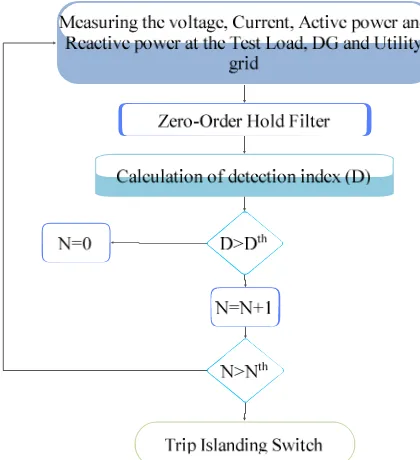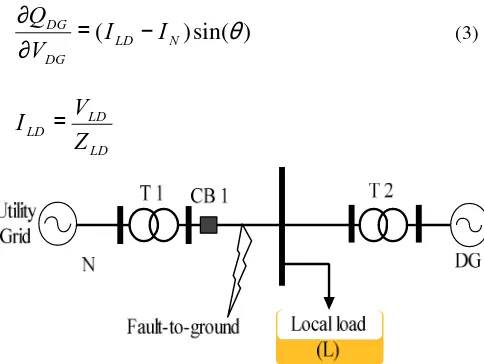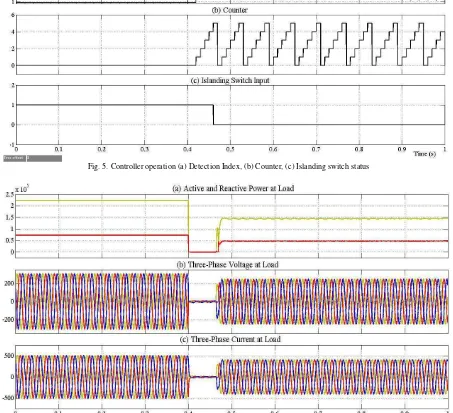Abstract— Micro-grids usage among consumers has become a new attraction due their several of advantage. Its major function is to ensure the stable operation during the fault and a variety of utility grid disruption. Since the utilization of micro-grid became common, the correct application and operation of micro-grid is importance and significant. One of the main challenges in micro-grids operation is islanding detection methods. There are several methods that are handles the islanding detection that each one have advantage and some disadvantage. This paper presents and investigates the Reactive Power imbalance Method for islanding detection. The passive algorithm implements in this paper due to the low cost operation, however it got the higher non-detection zone (NDZ) and slower response time compare some active methods. The micro-grid simulation is modeled in Matlab/Simulink program and the results of the monitoring are discussed as well. As the result, the performance of the Reactive Power Imbalance method for the islanding detection state is compared with the simulation model without control algorithm. Finally, the micro-grid model capability with control algorithm is shown in order to meet the load demand.
Index Terms—Micro-grid, Islanding Detection, Passive method, Distributed Generation.
I. INTRODUCTION
Micro-grid is a small power system that does not have transmission line. Micro-grid system is also known as a stand-alone system that has its own generator, controller and load. The generator of a micro-grid system is also known as Distributed Generator (DG). DG is a small source which is producing energy located at or nearly the point of use in micro-grid. DG typically includes internal gas turbines, micro-turbines, photovoltaic, fuel cells and many types of renewable energy [1, 2]. This micro-grid and utility grid such as Tenaga Nasional Berhad (TNB) in Malaysia supplies the same load as shown in Fig 1. The demand on the power supply is being shared by the DG. Both the DG and the utility grid are connected at the Point of Common Coupling (PCC). When the fault occurs in the utility grid, the islanding switch will open. At this point, micro-grid will tend to perform the operations of an islanding mode.
Manuscript received January, 2014.
Meysam Shamshiri, Faculty of Electrical Engineering, Universiti Teknikal Malaysia Melaka, Durian Tunggal, Malaysia.
Ahmad Farid Sapar, Faculty of Electrical Engineering, Universiti Teknikal Malaysia Melaka, Durian Tunggal, Malaysia.
Chin Kim Gan, Faculty of Electrical Engineering, Universiti Teknikal Malaysia Melaka, Durian Tunggal, Malaysia.
Revinnath Tengga Daram, Faculty of Electrical Engineering, Universiti Teknikal Malaysia Melaka, Durian Tunggal, Malaysia.
Mohd Ruddin AbGhani, Faculty of Electrical Engineering, Universiti Teknikal Malaysia Melaka, Durian Tunggal, Malaysia.
Fig. 1. Construction of a Utility Grid with the Distribution Generator (DG).
Islanding mode has two types such as intentional and unintentional Islanding [3]. Intentional islanding happens with a planned shutdown of the utility grid during maintenance whereby unintentional islanding mode happens during unplanned shutdown of the utility grid due to fault. This unintentional islanding mode is unknown because the load is still managing to supply power by the DG. One of the most important issues of micro-grid is when the grid become unavailable the micro-grids must be isolated itself from the grid and must not transfer the power to the grid. It is important in terms of safety to let to the utility grid to stay in normal operation and restore the power to the system.
The islanding detection method includes two important categories which are Local and communication methods. Local methods are divided into major group; passive and active methods. Passive methods are based on measuring some parameters of the power system at Point of Common Coupling (PCC) and analysis them to detect the islanding. Each parameter has certain range and normal operation; if the measured value is not satisfied with the range the algorithm will detect the islanding. The measured parameters can be voltage, current, frequency, power and etc.
Active methods will decrease the errors of passive methods with positive feedback or distortion controller. Communication methods are based on measuring the critical element of a power system in both utility grid and micro-grids and collect these data and transfer the signal data with using communication. The important point of communication methods is the way of transferring data. In Power Line Carrier Communication (PLCC) the interface data transfer is a power transmission line but in Supervisory Control and Data Acquisition (SCADA) the data exchange interface can be any kind of communication methods such as wireless, mobile, high speed LAN, broadband and etc. [4].
There are few advantages of using a micro-grid system such as flexible of locating DG nearer to the load area. It is because DG is a small-scale power system grid. Besides, DG is capable of improving the reliability of power usage at load. It supplies power although power failure occurs in the utility grid line. In addition, DG also reduces transmission losses, reduces cost of cables to set up transmission network, reduces the peak demand at national grid system, and defers the
Reactive Power Imbalance Method for Islanding
Detection in Micro-Grid Operation
investment [5, 6]. On the other hand, it also have disadvantages such as maintenance cost, protection during fault for the load and intermittent; not consistent of power flow to the load. Table 1 shows the characteristics of various islanding detection methods [3].
From the below characteristic table of each method, this project will be implementing the passive method to detect
[image:2.595.49.550.150.300.2]islanding mode. It is due to its low cost. From the table it is well known that the passive method is cheap, but it has a large portion of non-detection zone (NDZ) and the response time is much slower than the other three methods such as active method, utility method and communication based method.
Table 1: Comparison of various islanding detection method characteristics
II. METHODOLOGY
The method that is proposed to use is the passive islanding detection method. The major idea of passive method is measuring the parameters of the Distribution Generator (DG) and then comparing it with the parameters’ preset value of the main grid. Many parameters can be analyzed for detection method such as frequency, voltage, active power etc. In this paper, the parameter that will be analyzing is the reactive power. This method is also known as reactive power imbalance whereby it will detect the islanding state based on voltage as shown in Fig 2.
Fig. 2. The reactive power imbalance algorithm
At first, should form the Distribution Generator (DG) that work as a core for the micro-grid. DG works as a supply standalone supply that supports the local load. Then measure the three phase voltage, current, active power and reactive power of the DG, local load and main grid connecting to the local load. The signals measured should be converted to
discrete using the zero-order hold (ZOH) filter [7]. Calculation of detection index (D) is performed after the discretization process. DI is calculated as DI= (∂V_DG)/(∂Q_Load ) [7], will be explained in Calculation
section.
The value of DI is then compared with the set preset threshold value of DIth. The DIth is set as one. If the amplitude
of DI is larger than the DIth, the number of counter, N will
increase by one and will repeat the process until the number of counter that is called as Nth. If Nth is five, the islanding switch
will trip the connection of utility grid from the local load. At this point, the local load is connected to the micro-grid as in an islanding state. During islanding state the local load is supplied with the same amount of reactive and active power that does not affect the load. The transition time of the power system from the non-islanding state to islanding state is dependent on the Nth value of the counter. According to IEEE
1547 standard the reconnection time of the local load to the supply should be within 0.16s [8]. The simulation of the micro-grid is done over the MATLAB/ Simulink software.
III. FORMULATION
The calculation is performed by comparing two power system circuits which are the non-islanding state during normal condition and during fault-to-ground condition. The circuits are shown in Fig. 3.
N represents the main network to the grid system whereby DG represents the micro-grid system and L represents the local load. During fault-to-ground condition the current from the main network and the DG will be grounded, so lesser voltage magnitude will be reaching the local load. This condition will affect the local load. The calculation is done by obtaining the DG reactive power equation (QDG) which is:
)
sin(
)
)(
(
DG DGθ
DG
V
I
Q
=
(1)where, VDG, IDG, θ is the DG voltage, DG current and the
phase angle between DG voltage and DG current, respectively [9]. During normal conditions, the load current (ILD = IN + IDG) therefore, the DG reactive power can be
written:
Characteristic
Local detection method Remote detection method
Active Method Passive Method Hybrid Method Utility Method Communication Method
Operations
Injection of disturbance signal
at parameters
Monitoring the parameters at
PCC
Combination of passive and active
method
Installing specific equipment at
utility
Installing communication
equipment
NDZ Small Large Small None None
Response time
Slightly shorter than passive
method
Short Longer than active
method Fast Faster
[image:2.595.58.268.456.686.2])
sin(
)
)(
(
DG LD Nθ
DG
V
I
I
Q
=
−
(2)IN is the current from the main grid. Eq. 2 is then
differentiated to obtain the rate of change of reactive power over its DG voltage for normal condition as in Eq. 3:
)
sin(
)
(
LD Nθ
DG DG
I
I
V
Q
=
−
∂
∂
(3) LD LD LDZ
V
I
=
Fig. 3. Power system circuit fault-to-ground condition
Then the inverse of Eq. 3 will produce the value of Detection Index (DI). DI is the rate change of DG voltage over its reactive power for normal condition.
)
sin(
)
(
1
)
sin(
)
(
LDθ
Nθ
LD DG DG
I
V
Z
D
V
−
=
∂
∂
(4)For fault-to-ground condition, the voltage at load will reduce and the amount of active and reactive power to the load will reduce drastically. From Eq. 4, the value of the second part of Eq. 4 will affect the value of DI. The DIth threshold value is measured by the Eq. 5 [9].
)
sin(
)
)(
(
)
sin(
)
(
θ
ϕ
LD LD DG DG DG thV
Q
S
D
V
DI
=
∂
∂
=
(5)SDG and
ϕ
in Eq. 5 are the DG apparent power and thephase angle between the load voltage and load current respectively. The value of DIth is adjusted to one. When the power system circuit is having fault-to-ground the value of DI will be more than one. When the islanding switch disconnects the main grid from the local load, the DG will supply the local load with the same value of the voltage magnitude, current, active and reactive power. This state is called as the islanding state of the micro-grid. The value of DI in islanding state is calculated as follows in Eq. 8.
LD DG
I
I
=
LD LD LDZ
V
I
=
LD LDY
Z
=
1
)
)(
(
LD LDLD
V
Y
I
=
)
sin(
)
)(
(
DG LDθ
DG
V
Y
Q
=
(6)Eq. 6 is then differentiated to obtain the rate of change of reactive power over its DG voltage for islanding state in Eq. 7.
)
sin(
)
)(
(
LD LDθ
DG DGY
V
V
Q
=
∂
∂
(7)Then the inverse of the Eq. 7 will produce the value of Detection Index. DI is the rate change of DG voltage over its reactive power for islanding state.
)
sin(
)
(
)
sin(
)
)(
(
1
θ
θ
LD LD LD LD DG DGV
Z
Y
V
D
V
DI
=
=
∂
∂
=
(8)IV. SIMULATED TEST SYSTEM
A case study of power system is shown in Fig 4. It shows Matlab\Simulink micro-grid model which the three phase fault-to-ground in the model which occurs at 0.4s of the simulation time until to the end of the simulation. The value of DI will be more than one during the fault-to-ground condition which is at 0.4s of the simulation time. As shown in Fig 5(a) the detection index is changed after initializing the reactive power imbalance control. At this time the counter starts to count from 1 to 5 as Fig 5(b) and at the 5th counter the input of
the circuit breaker will be high level. Which means it will open the islanding switch to disconnect the utility grid from the local load. The islanding switch status should be changed to zero to open the normally close islanding switch. Therefore, the islanding switch status signal will be sent to the NOT logic gate to give the desired signal as Fig 6(c) for the islanding switch to open status. When the signal is provided, the circuit will be stated the islanding. Thus, the micro-grid at this time has been converted to islanding situation. The active and reactive power of load with reactive power imbalance control is shown in Fig 6(a) to indicate the effect of fault-to-ground on load. The fault occurs after the 0.4s until the end of the simulation time but control managed to disconnect the utility grid from the local test load. During fault the current from the utility grid and the micro-grid are grounded due to fault-to-ground. Therefore at this time the load is supported by very small current magnitude due to current divider rule. The load is supplied with the same amount of voltage and current at the islanding status. This shows that after the 5th counter the micro-grid is in the
Fig. 4. Micro-grid model with control block diagram
Fig. 5. Controller operation (a) Detection Index, (b) Counter, (c) Islanding switch status
V. CONCLUSION
This paper investigates the micro-grid operation from the grid connected to islanding modes. The main objective of this paper is to detect islanding state in the grid connected power system. After the fault occurrences, the reactive power imbalance control will send signal to the islanding switch to open the circuit. The islanding state will isolate the fault-to-ground condition from affecting the load demand. At this point, the load is back to its initial demand value within 0.16s of reconnection time according to IEEE 1547 standards. The Matlab/Simulink is used to model the micro-grid simulation. The results of the simulated model show that the Reactive Power Imbalance method was successful to achieve the load demand during a fault.
ACKNOWLEDGMENT
The authors would like to gratefully acknowledge the funding support provided by the Ministry of Higher Education Malaysia under the research grant NO. MTUN/2012/UTEM-FKE/7 M00015.
REFERENCES
[1] B. Kroposki, T. Basso, and R. DeBlasio, “Microgrid standards and technologies,” Power and Energy Society General Meeting - Conversion and Delivery of Electrical Energy in the 21st Century, 2008 IEEE, pp. 1–4.
[2] Khamis, Aziah, Hussain Shareef, Erdal Bizkevelci, and Tamer Khatib. "A review of islanding detection techniques for renewable distributed generation systems." Renewable and Sustainable Energy Reviews 28 (2013): 483-493.
[3] W.Y. Teoh and C.W. Tan, “An Overview of Islanding Detection Methods in Photovoltaic Systems,” World Academy of Science, Engineering and Technology, pp. 674–682, 2011.
[4] M. Shamshiri, C.K. Gan, and C.W. Tan, “A review of recent development in smart grid and micro-grid laboratories”, IEEE International Conferences on Power Engineering and Optimization Conference (PEOCO) Melaka, Malaysia, June 2012, pp. 367–372, 2012.
[5] G. Strbac, N. Jenkins, T. Green, and D. Pudjianto, “Review of Innovative Network Concepts”, Imperial College London and University of Manchester, 2006.
[6] D. Pudjianto, P. Mancarella, C. K.Gan, G. Strbac, “Closed loop price signal based market operation within Microgrids”, European Transactions on Electrical Power, 2011, 21(2), 1310-1326.
[7] G. Bakhshi, M Noroozian, Reza Gharehpetian, “Passive anti-islanding scheme based on reactive power in the smart grids,” Iranian Conference on Smart Grids (ICSG), vol. 5, pp. 1–7, 2012.
[8] IEEE.Standards, “IEEE Standard for Interconnecting Distributed Resources with Electric Power Systems,” The Institute of Electrical and Electronics Engineers, Inc., no. July, 2003.
[9] R. Bakhshi, M. Noroozian, “Reactive Power Based Anti-Islanding Scheme for Synchronous Distributed Generators,” IJTPE Journal, iotpe.com, vol. 4, no. 13, pp. 30–37, 2012.
Meysam Shamshiri was born in Iran in 1983. He received his B.Eng in Electrical & Electronic Engineering from Islamic Azad University, Toyserkan, Iran in 2008. He received his M.Eng from Universiti Teknikal Malaysia Melaka (UTeM) in electrical engineering (Industrial Power) in 2013. He is currently a PhD student and research assistance in the Faculty of Electrical Engineering at UTeM. His research interests include distribution network planning, smart grid and integration of renewable energy.
Ahmad Farid Bin Sapar received the Bachelor Degree (Industrial Power) in Electrical Engineering from Universiti Teknikal Malaysia Melaka (UTeM), in 2012. He is currently a Master student at the same university as Graduate Research Assistant (GRA). His research interest includes the development of islanding detection interface for renewable energy connected to grid.
Chin Kim Gan received his B.Eng and M.Sc degrees both in electrical engineering from the Universiti Teknologi Malaysia (UTM) and PhD degree from the Imperial College London, UK. He is currently a Senior Lecturer at the Universiti Teknikal Malaysia Melaka (UTeM). His research interests are distribution network design, integration of renewable energy and smart grid.


